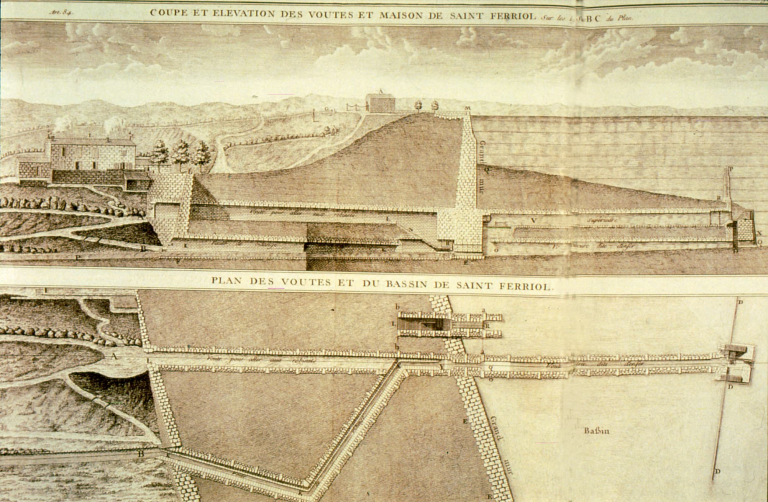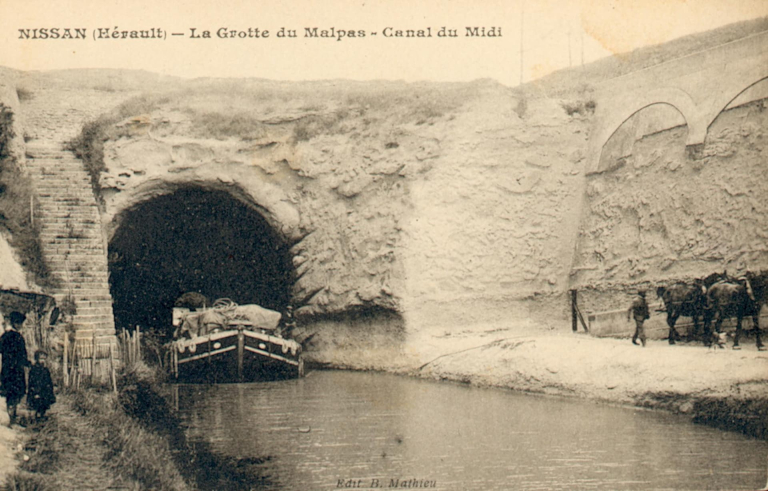
Construction of the Canal du Midi
between 1666 and 1694: one of the most significant construction projects of the 17th century
The Canal du Midi is an exceptional creation and is one of the most significant construction projects of the 17th century. This creation is both a work of art and a technical feat, and it only took 14 years to build the Canal du Midi and then open the waterway to allow boats to sail between the Mediterranean and the Atlantic. At a length of 240 kilometres, the Canal du Midi was a real revolution in inland waterway transport, in France and across the globe.
The Canal du Midi:
the great project from Pierre-Paul Riquet
Pierre Paul Riquet wanted to build a canal to link Toulouse and Narbonne
The idea to dig out a canal between the Mediterranean and the Atlantic was not a new one though!
Before Louis XIV, Emperor Augustus, Charlemagne, Francis I and Henry IV all looked into the feasibility of such a project. Why? Providing a link between the Mediterranean and the Atlantic would mean that boats would no longer need to go around the Iberian Peninsula and the Straits of Gibraltar, controlled by the Spanish crown. An excellent way to avoid the taxes involved, as well as the pirates and other privateers known for their barbaric behaviour in these waters.
The construction of a canal between the two seas was therefore key, both on a political and economic front. But to make it happen, a solution needed to be found for the canal water supply. A canal between two seas passes via a summit level, and water needs to be supplied along the entire route!
In 1662, from his Château de Bonrepos, Pierre-Paul Riquet submitted a proposal to Colbert, controller-general of finances for the Kingdom, detailing his project to link Toulouse and Narbonne, and how he planned on implementing his idea.
Thanks to his knowledge in hydraulics, Pierre-Paul Riquet came up with an ingenious system to collect the waters of the Montagne Noire and therefore, supply the canal with water all year round.
Louis XIV ordered the construction of the Canal du Midi
Louis XIV was keen on the project. The King saw an opportunity to mark his reign with an ambitious project that presented numerous economic benefits for him and for his people. In January 1663, Louis XIV ordered auditors from the Kingdom and the Province of Languedoc to assess the project.
Pierre-Paul Riquet carried out an experimental study and in November 1664, after the project had been examined in great detail, the Commission of Inquiry approved the construction of the Canal du Midi.
It wasn't until October 1666 and the Edict of Saint-Germain that the authorisation to dig out the canal was signed. This Edict appointed Pierre-Paul Riquet as adjudicatee of the construction work for the canal from Toulouse to Trèbes. The work could then begin!
A timeline of the construction of the Canal du Midi
The work got off to a flying start.
The first construction work began in the Montagne Noire region. The first construction company started with the Rigole de la Plaine channel.
The first foundations began for the Saint-Ferréol dam.
Then came building work on Saint-Ferréol lake. This was one of the most significant parts of Riquet's project, and it was the first lake-reservoir of this size to ever have been built.

Foundations began for the Embouchure lock at the mouth of the Garonne in Toulouse.
To mark the occasion, Riquet organised a grand ceremony and invited political and religious authority figures. Commemorative bronze medals were coined and thrown into the crowds.
The second part of the canal between Trèbes and Thau lagoon was assigned to Riquet, as well as the construction of the port of Sète.
The first section of the canal between Toulouse and Castelnaudary was inaugurated and opened to navigation.
Construction of the Fonseranes lock with eight chambers near Béziers, the canal's most impressive engineering structure! It is around 300 m long and allows boats to overcome a difference in height of 25 m.
Work began on digging out Malpas tunnel in Nissan-les-Ensérunes.
This was the last significant construction site managed by Pierre-Paul Riquet. At Le Malpas, the canal crossed over the watershed point between the Aude and Orb rivers. The challenging topography here is what led Riquet to dig out this 160-m-long tunnel for the canal route. This was one of Riquet's most iconic achievements as it was a risk in terms of technical credibility to create a structure of this kind, in this location. The Malpas tunnel is the oldest navigation tunnel in Europe.

The entire canal was filled with water for the first time, and the first boats sailed on the canal.
After 14 years of construction work, the canal was completed. On 15 May 1681, a convoy of 25 boats left Toulouse for the very first time. When they passed through Béziers, Riquet's hometown, there was a big celebration. After sailing for 10 days, the convoy arrived at the port of Sète, completing the route between Toulouse and the Mediterranean for the very first time.
Key figures of the history of the Canal du Midi construction
from 1666 to 1684
-
14 years to build
-
240 kilometres long
-
12,000 workers
-
17,160,000 million pounds
The construction of the Canal du Midi:
a colossal undertaking
The Canal du Midi was an impressive technical achievement
Besides Versailles, the Canal du Midi was the most significant construction project of the 17th century. This was because it wasn't just one project, Pierre-Paul Riquet was in fact managing a dozen projects all at once.
The methods used to build the canal were a real technical achievement for the era! Excavation, locks with several chambers, bridges, aqueducts, navigable aqueducts, dams and so much more. Just take a moment and imagine the ingenuity and creativity shown by Riquet to build these engineering masterpieces! Saint-Ferréol dam is one of the most impressive creations, and at the time it was the biggest man-made water reservoir in the world.
12,000 people were involved in Pierre Paul Riquet's project
To carry out such a project, Pierre-Paul Riquet needed to call upon professionals who were experts in their fields. That is what led him to contact cartographer François Andréossy and architect Emmanuel de l’Estang, who was already well-known for his work on building Répudre aqueduct.
But the construction of the Canal du Midi also required a whole host of other professions. Builders, stonemasons, blacksmiths, etc. Over the course of almost 15 years, 12,000 workers played a part in building the Canal du Midi. Everything was done by hand, using shovels and pickaxes. It was intense, gruelling and tiresome work.
To make sure the deadlines were met and to encourage workers not to leave this work and go back to the harvests in the fields, Pierre-Paul Riquet gave his workers advantageous working conditions, including higher salaries, days off, paid sick days and paid non-working days... Yet again, Riquet demonstrated that he was ahead of his time!
Did you know?
Pierre-Paul Riquet would never see his canal entirely filled with water, and would never witness the sheer popularity of his masterpiece. Exhausted by this mammoth project and submerged in debt, he fell seriously ill and died on 1 October 1680 in Toulouse, just a few months before the end of the construction work. It was his eldest son, Jean-Mathias Riquet, who took over and completed the construction of the canal.
How was the Canal du Midi construction work financed?
As you can imagine, a project of this size requires significant financial means. Initially, Pierre-Paul Riquet used his own personal funds for the construction work, before then getting financial support from the Trésor Royal and the Estates of Languedoc.
The construction of the canal cost around 17,160,000 pounds, provided as follows:
- 8,485,000 pounds from the Trésor Royal,
- 8,070,000 pounds from the Estates of Languedoc,
- 605,000 pounds from Riquet himself.
Financers from Languedoc such as Pierre Louis Reich de Pennautier also assisted in funding the project.
Did you know?
In 1668, King Louis XIV made the fiefdom of the canal available at auction. That is how Riquet became the lord and master of the Canal du Midi! From then on, he was responsible for the maintenance of the canal and was also the beneficiary of all revenue generated by the canal, from the 'barque de poste', the toll fee for goods at the revenue offices, rental of storehouses, revenue from mills, the use of open land, etc.
Vauban's consolidation work for the Canal du Midi
Vauban and the Canal du Midi
In July 1684, three years after the Canal du Midi was filled with water, an inspection was carried out by Languedoc steward Henry Daguesseau, to assess the structures. The resulting observation was that the canal was silting up and some of the engineering structures had deteriorated. The cost of the required maintenance work would not be compensated by the navigation taxes and Riquet's heirs were crippled by the increasing debt.
In 1686, Louis XIV called upon Vauban, Commissioner General of Fortifications for the Kingdom, to carry out an inspection of the canal. He recommended the construction of multiple structures to limit the increasing sand deposits and to boost the water resources in the Montagne Noire region.
From 1687, another period of construction work began on the Canal du Midi. And the planned work was by no means minor! Following the recommendations from Vauban, the Commissioner General of Fortifications for the Kingdom, to the letter, Antoine de Niquet planned for:
- The construction of 48 aqueducts and navigable aqueducts, based on the model of the Répudre aqueduct, one of the few built by Riquet. These structures would guide the canal up over the rivers, therefore protecting it from floods and any risk of silting.
- The creation of irrigation canals to drain run-off flows that were damaging the canal dams.
- Raising Saint-Ferréol dam to increase capacity from 4 to 6.3 million m3.
- The creation of Cammazes tunnel to boost the water supply system. This 'water tunnel' would be used to guide the water from the mountain channel directly into the Laudot, the stream which supplied water to St Ferréol reservoir.
- The construction of new bridges to restore any links that had been cut off by the canal.
The Canal joining the two seas is undoubtedly the most beautiful and most noble structure of its kind to be created at this time. It could have become the wonder of the century if it had been taken to its full potential, to really benefit from a creation of this kind, an unbelievable achievement which provides access to a sea at either end, and which crosses through the best regions in the world. The achievement of a canal and side channels that are supplied with water from so far away and from such a challenging environment will always be worthy of admiration, even from the most talented of people in the field of civil engineering
Mr. de Vauban
Extract from the memorandum on the 'Canal de Jonction des Mers', 5 March 1686
1694: the end of the Canal du Midi construction work
In 1694, the improvement work led by Vauban and Antoine de Niquet was completed. The canal was officially finished! Altogether, the construction of the Canal du Midi would have cost almost 17 million pounds, plus the cost of the structures built for Vauban's consolidation work.
To pay their debts, Pierre-Paul Riquet's heirs were obliged to sell some of their shares of the Canal du Midi. Reich de Pennautier and Antoine de Niquet bought some of them. But in 1725, Pierre-Paul Riquet's heirs chose to enforce a no surrender clause and were once again the sole owners of the canal. This was the case up until the French Revolution.



